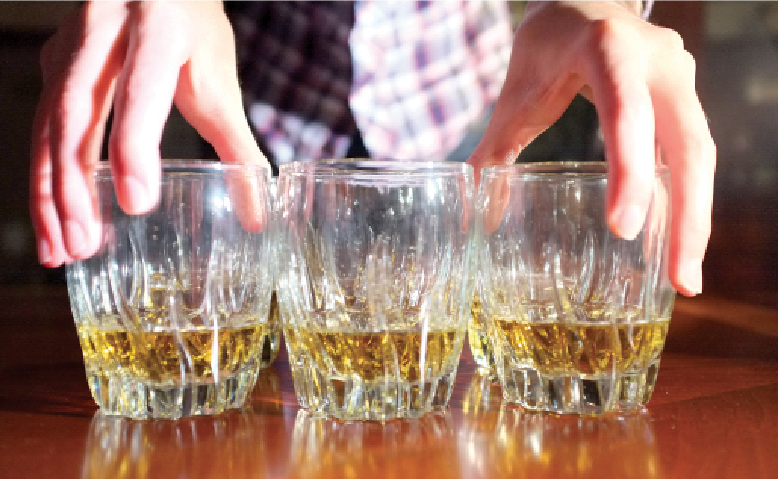

Twenty-five percent of college-aged women binge drink, according to a recent study from the Center for Disease Control.
Young women are increasingly turning to alcohol and booze-filled nights for recreation and stress relief, according to a recent Center for Disease Control study.
Drinking among female

College-aged women are surpassing men in binge-drinking statistics.
s, particularly young females aged 18-34 is on the rise and is a major health risk. According to the CDC study in Morbidity and Mortality Weekly Report, binge drinking and excessive alcohol consumption results in about 23,000 deaths of women per year.
Binge drinking is most common among the Caucasian and Hispanic demographic and women with household incomes above $75,000.
Twenty percent of high-school aged girls and 24 percent of women aged 18-24 participate in binge drinking, according to the CDC study.
This type of drinking also entails very dangerous risks to women and girls, including unintended pregnancies, sexual assault, homicide, suicide and falls. Alcohol also increases the risk for breast, liver, mouth and throat cancer.
“Women do it to have fun and face the same risks as everyone else when they drink alcohol. Damage to the liver, pancreas can happen and also they can be sexually assaulted,” said Milagros Marshall, registered nurse at the Grady Emergency Room. “It is very common to see cases of excessive alcohol abuse [here at the Emergency Room].”
The study showed one in eight women, age 18-24, binge drink at least three times a month, and one in five high school girls binge drink at least once a month.
The CDC defines binge drinking for women as having more than four drinks in a short period of time. Women of college age were shown to drink an average of six “standard-size” drinks in one sitting.
This can be attributed to “non-standard” amounts of alcohol being consumed, such as oversized beer cups, mixed drinks, and extra-large shot and wine glasses. This occurs frequently in college settings.
According to another study the CDC published three days prior to the study on women, binge drinking has also increased among Americans in general.
“Excessive alcohol consumption, including binge drinking, accounts for 80,000 deaths in the U.S. each year, making it the third leading preventable cause of death,” said Ursula Bauer, director of the national center for Chronic Disease Prevention and Health Promotion in the study.
Those deaths are typically the result of vehicle-related incidents or violence against others while under the influence.
“The long term effects of binge drinking are also very damaging. There is deterioration of the teeth, people also suffer problems with the liver and pancreas as well as mental problems. Seizures and conditions such as delirium tremens can be fatal,” Marshall said.
Alcohol has always been a drug of high abuse among college students. The increase of binge drinking, when alcohol is consumed, is particularly troubling and harmful for young women.
Although binge drinking is more common in men it is an important and under-recognized health issue for women, said Dr. Thomas Frieden, CDC Director in the study, according to CNN’s blog.
In the study, concerns were expressed for the health of women who binge drink due to the fact that women get drunk more easily than men, as they are often smaller. .
Georgia State student and sophomore, Sara Shahgholami said stress and pressures on women can turn them to binge drink.
“Life is stressful, in terms of the pressures of life, of the media and society, and work,” Shahgholami said.
Sophomore Jessica Baxter believes that as the expectations and responsibilities of women increase they are more prone to binge drink.
“Honestly I think a lot of people drink just to have fun. People do it to, I guess, to ‘turn up’ or whatever. It’s easy [for students] to get,” Leena Manzoor, Georgia State sophomore said. “I don’t know that there’s an exact amount for ‘binge drinking’ because everyone is different. If they start getting loud or dancing they might have been binge drinking”
The perception of binge-drinking at Georgia State is also mixed among students.
“I live on campus and sometimes I feel the RA’s don’t always pay attention to it…it happens all the time. If the school really wanted to do something about it they could. [They were] stricter about it at the Commons than the Lofts,” Baxter said. “It depends on who’s on duty. Not all of the employees are equally strict.”
Greater enforcement of alcohol policies and possibly requiring first year students to live on campus could help curb the problem.
“One way that could possibly stop it, or slow it down, is forcing freshmen to live on campus. I know UGA and Tech do that and they can monitor the students,” Manzoor said.
Both the CDC and Georgia State students agree one of the things that can be done about the issue is greater education.
The CDC recommends women avoid binge drinking and follow the U.S. Dietary Guidelines (one drink for women, two for men). Women should choose not to drink if there is any chance they could be pregnant and be cautious of consuming drinks where the alcohol content is unknown. The CDC says federal agencies and national partners are working with states and communities to support actions to reduce binge drinking. Agencies will also help states and communities report binge drinking statistics and whether health care providers screen and counsel for excessive alcohol use.
States and communities can increase enforcement of the laws on sale and consumption of alcohol and also develop partnerships with groups, including schools.
